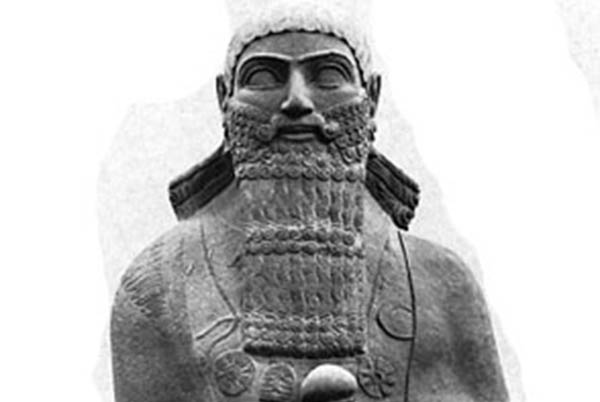For two decades Ahuni the King of Bit Adini led the resistance against Assyria.
After the end of the Bronze Age, for two centuries, the Assyrians had been in decline as a political power in the Near East, Then a slow resurgence in Assyria during the early 9th century gave rise to the renewed conquests of Ashurnasirpal II (883-859 BCE). The Assyrians had slowly expanded westward and by the 880 BCE they counted newly settled Aramaean tribes along the Khabur River in Syria as their vassals. To the west of those vassal tribes was the Aramaean Kingdom of Bit Adini located along the curve of the Euphrates River. The King James Bible translates Bit Adini as the House of Eden. ( Amos, 1:5)
The capital of Bit Adini, located to the south of Carchemish, was Tel Barsib. The city was known as Masuwari during the Late Bronze Age when the region was dominated by the Hittites. By the time of Bit Adini the Luwian language used by the Neo-Hittites had been replaced with Aramaic. The regions art and architecture was based on Hittite, Egyptian and Mesopotamian influences. This multinational influence demonstrates the importance of the Upper Euphrates River in Central Syria as a crossroads for trade and cultural exchange.
In particular Tel Barsib is known for its carved ivories, many of which have been found intact during excavations. The Ivories show both Assyrian and Egyptian influence and are related in style to other works of art found as far afield as Sardinia.
Ashurnasirpal Invades Syria
Ashurnasirpal’s grandfather, the Assyrian King Adad-nirari ( 911-891 BCE), had secured a peace with Babylonia; therefore, once Ashurnasirpal stabilized his eastern and northern frontiers he was able to set his sights on the strategically important lands of the House of Eden.
In 877 BCE Bit Adini was drawn into one of Assyria’s frontier wars and Ashurnasirpal invaded the small kingdom in retaliation. The attack was followed by a successful Assyrian siege of the Bit Adini fortress of Kaprabi, which is likely to be equated with Urfa/Edessa. The Assyrian King used “mines, battering rams, and siege engines”, to conquer the city which “was exceedingly strong and hung like a cloud from heaven”.
The Assyrian victory at Kaprabi caused the King of Bit Adini, Ahuni son of Hateni, to offer tribute and hostages to the Assyrians. When the Assyrian king marched into Central Syria the following year Bit Adini offered no resistance. Ashurnasirpal marched to the Mediterranean receiving tribute from most of the cities and kingdoms along the way.
In the end Ashurnasirpal’s invasion turned out to be only a raid bent on plunder. The only long term expansion was a few new strongholds which were established on the middle Euphrates.
Ahuni versus Shalmaneser III
Over ten years had passed when ca. 858 BCE Ashurnasirpal’s son, Shalmaneser III (858-824 BCE) launched another invasion towards the west. The first Assyrian strike captured the Bit Adini town of Lahlahte. However this time Ahuni was not cowed and launched a counterattack. The Assyrians rebuffed his efforts and report having killed 300 of Ahuni’s soldiers. With this victory several rulers from the west bank of the Euphrates offered tribute to the Assyrians. Ahuni was forced to seek refuge in his fortified capital Tel Barsib while Ashurnasirpal was free to cross over the Euphrates using “inflated skins”.
Ahuni crossed the river in pursuit of the Assyrians and the two armies met again near the city of Pagarruhbuni, where Ahuni was again defeated losing 1300 of his troops. With this second Assyrian victory over Bit Adini even more Syrian monarchs offered tribute to the Assyrian king. However Ahuni was still in the field and was attempting to rally fresh allies. His efforts were successful and Hani, king of Samala, Sapalulmi of Patina, and Sangara of Carchemish all joined him to resist the Assyrian advance.
The Assyrians met up with Ahuni and his allies in the land of Samala and for a third time the Assyrians prevailed with a clear victory. Shalmaneser then set about attacking Patina which was further west in Syria beyond the Orontes River. Shalmaneser then repeated the westward progress of Ashurnasirpal and set up a memorial on the shores of the sea.
In 857 BCE Shalmaneser marched his army once more against Bit-Adini, this time striking directly at its capital Tel Barsip. Ahuni gave battle to defend his city but was defeated once again and forced to retreat across the Euphrates. This left the Assyrian king to impose a heavy tribute on chieftains in the subdued territory.
In the following year Shalmaneser attacked again but this time Ahuni had already retreated to the west bank of the Euphrates and positioned himself there in the rugged hill country. The Assyrians attacked several small towns and laid waste to the Aramaean kingdom of Ararat but Ahuni remained elusive.
The fourth year of the war brought another Assyrian offensive. Ahuni still held one corner of his lands in the northern region of Sitamrat. The Assyrians attacked him there and dealt him a final defeat. After four years of struggle the King of Bit Adini and all of his people surrendered to Shalmaneser. According to the Book of Amos these prisoners were relocated to the city of Kir which was to be found east of the Jordan River.








